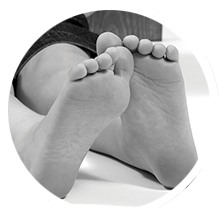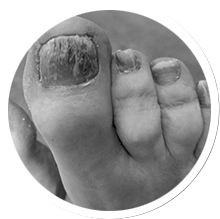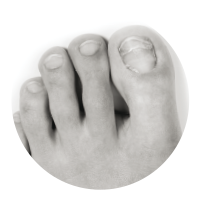Foot Dermatology
Athlete’s Foot
Athlete’ s foot is a skin fungal infection. It can lead to intense itching, cracked, blistered or peeling areas of skin redness and scaling.
How do I know I have it?
It usually occurs in moist waterlogged skin between the 4th and 5th toes initially, or on dry flaky skin around the heels or elsewhere on the foot. Large painful fissures can occur and spread along all five toes and sometimes to the soles of the feet if left untreated.
What causes the problem?
It’s caused by a number of fungal species which you can pick up from someone else shedding affected skin (typically in communal areas such as gyms, showers, swimming pools and communal changing areas.) , or anywhere you walk around in bare feet. Athletes foot can also be passed on by person to person contact, although people who perspire more are more susceptible to the infection.
The infection thrives because once your feet have been contaminated foot wear provides the ideal conditions for fungi to survive, as they provided a warm, dark and sweaty environment. However athletes foot can also be found on summer feet that are exposed to the environment in sandals. The sun dries out the natural oils in the skin and combined with constant trauma from sandals makes them susceptible to infection.
Is it serious?
If left untreated, the fungus can spread to the toe nails causing thickening and discolouration of the nail, often a honey comb appearance which is much more difficult to treat. Fungal infections are highly contagious and can spread to your scalp, hands and even your groin. So it is important when you have the infection to use a separate towel to dry your feet to prevent cross infection. Family members or co-habitants should not use the same towel to prevent the spread of infection. It is always important to treat the infection as soon as symptoms are first noticed.
Who gets it?
Predominantly active individuals who have sweaty or dry feet . Diabetic patients often suffer with this condition as their skin may be ischaemic and dry, the risk of this being untreated may develop cellulitis.
Can a Podiatrist help treat this condition?
Make an appointment and we can establish a treatment plan to eradicate the infection.
Verrucae
Verrucae and planter warts are common amongst all age group, they are a viral skin infection that is caused by the HPV (human papilloma virus). The are many types of the virus and some patients present with a single lesion or others may present with multiple mosaic types that cover the digits and planter aspects of the foot. They tend not to be painful unless squeezed, pinched or constant pressure applied. They are benign skin lesions. At Dalkey Podiatry we use Swift Microwave Therapy, Cryotherapy and Chemical debridement to treat these conditions.
Wound Care and Ulcer Management
Podiatrists have a depth of knowledge and experience in Wound-care management. Wound care is now an international science as millions of euros are spent each year developing research, new drugs and dressings to treat the different types of wounds. With the increase in Diabetes, Podiatrists have a very specialist interest in wound care and management. As practitioners we have become the first line management in wound care of the lower limb. At Dalkey Podiatry Clinic we feel it is important to continually update are skills and knowledge in this ever changing specialist area. We are the only Allied Health Profession who are skilled in Ulcer debridement by scalpel. This is essential to us managing Diabetic foot ulcers and preventing amputations. We are experienced in diagnosis and management strategies using the most up-to date dressings available to manage each individual case.
Podiatrists are the only Allied Health Professional who can both manage the wound and improve the lower limb mechanics to reduce pressure load to assist wound healing.
Corns, Callous and Heel Fissures
Corns, callouses, fissures or cracks occur on the feet at the toes, on the sole of the foot and at the heel and sometimes can occur on the Hallux (first digit) or under the first metatarsal head. These occur because the skin has become dehydrated and there has been increase friction on an area.
Corns can become painful and inflamed, most commonly they can occur on the 2nd and 5th interphalangeal joint or toes. People can develop them between their toes sometimes known as a soft corn because the skin can be soft and macerated because the feet perspire.
Regular visits to the Podiatrists can help improve these conditions and relieve pain. Fissures that go untreated can become painful and infected. Podiatrists can manage and advise how best to manage this problem.
Childrens foot conditions
Flat feet
Many children present with flat feet where the arch has not developed by the age of seven. In most cases these children are a symptomatic and do not require intervention. However some children complain of pains in their legs, are not keen to walk very far and may have tendencies to trip or be a little bit clumsy . Also children who are keen on sport or dance, who play and train regularly can also develop symptoms as they go through growth spurts.
A visit to a Podiatrist can be of benefit, as we can set up a management plan involving stretching exercises, footwear advice and orthotic management. We at Dalkey Podiatry Clinic are all qualified Paediatric practitioners, Amber Coffey holds a certificate in Academic Achievement from NUIG for her expertise in the treatment of Children’s Foot Conditions.
Severe’s disease / paediatric heel pain
Children are commonly troubled with this condition. It is a traction apophysitis at the posterior heel. This often occurs when children are starting puberty and hey have taken a growth spurt, between the ages of 9 and 16. Their bones are developing faster than their muscles and ligaments. They complain of pain in the heel, have difficulty walking or running. The pain is worse in the morning or after sitting for long periods of time. They may complain of pain being worse after sporting activity.
This is a condition that can be well managed by a Podiatrist and at Dalkey Podiatry Clinic we are very experienced at treating this condition.
Osgood schlaters disease
Osgood-Schlatter disease is probably the most frequent cause of knee pain in children. The condition occurs most commonly in children between the ages of 9 and 16 years but it can occur in younger children. Both boys and girls are equally vulnerable to its debilitating effects. Osgood-Schlatter disease is always characterized by activity-related pain that occurs a few inches below the knee-cap, or patella, on the front of the knee. The child will have swelling in the area, and tenderness to touch. Sports requiring lots of running, jumping, kneeling, and squatting are particularly associated. Many children first signal the start of the problem by rubbing the top of their “shinbones” with their hands, or even ice cubes, at practice sessions. The three main factors that contribute to Osgood-Schlatter are:
- Between 9 and 16 years old.
- Involved in youth sports.
- In a “growth spurt”.
Podiatrists are experienced in managing this condition and at Dalkey Podiatry Clinic we can establish a treatment plan to manage this condition.
Biomechanical foot conditions
A Podiatrist has a vast knowledge of treating and managing lower limb foot conditions. Many patients present at the clinic with Heel Pain. Metatarsal pain and Achilles Tendon Pain.
Heel pain
Sharp shooting pain that occurs in the heel when you first get up in the morning , occurs after long periods of sitting or after playing sport. There are two different diagnosis of heel pain.
Firstly there is Planter fasciitis – inflammation of the planter fascia where it inserts into the calcaneus bone in the heel, when patients have this for a long period of time it can involve inflammation of the 5 layers of muscles that also insert into the calcaneus. It is a common condition occurring in the 40-60 age bracket often associated with runners but also in less active individuals, it is more prevalent in obese individuals.
Secondly patients can develop a bony heel spur in their heels that can feel like it is cutting through the muscle in their heel. It can be very severe and patients can have difficulty walking and continuing their regular exercise regime.
Treating this condition can be slow however Podiatrists can develop a treatment plan to manage this condition to restore you back to normal activity.
Metatarsal pain
Forefoot pain or metatarsal pain can be extremely debilitating. There are several differential diagnosis of forefoot pain.
- Metarsalgia – inflammation that occurs across the metatarsal heads that can tender to touch and difficult to walk or stand for long. Patients may present with callosities around the metatarsal heads. Patients may present with a subluxation of the 1st metatarsal head. Podiatrists can manage this using insoles to deflect pressure, an exercise programme to improve foot function and footwear advice.
- Capsulitis – this is when the capsule around the metatarsal head becomes inflamed and swollen independent to the other metheads, it is a painful condition that it is important to have the foot x-rayed to check for March fractures or Freiberg’s. At Dalkey Podiatry Clinic we are experienced to manage these conditions .
- Morton’s Neuroma- is commonly described by patients as a sharp shooting pain in the ball of the foot and toes where they have to remove their footwear and massage their foot to get relieve. The pain begins as a burning , tingling sensation which becomes more intense and neuralgic in nature. They often describe only being able to walk short distances.
It is a common paroxysmal neuralgia affecting the web space between the toes. Pain arises from a pathological plantar digital nerve as it divides to supply the adjacent sides of the toes it innervates. It can be presented bilaterally and women in their 30-60 age group are most commonly affected.
Podiatrists are experienced in managing and treating this condition, with casted orthotics, exercises and manipulation.
Error: Contact form not found.



